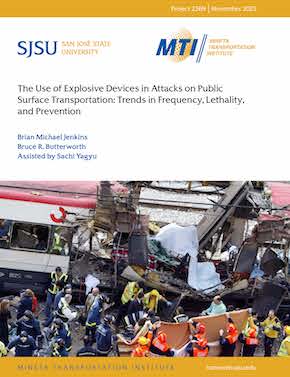- 408-924-7560
- mineta-institute@sjsu.edu
- Donate
The Use of Explosive Devices in Attacks on Public Surface Transportation: Trends in Frequency, Lethality, and Prevention
This report is the third in a series of MTI studies of the frequency and lethality of attacks on public surface transportation between January 2004 and December 2021. The first study, released in August 2022, Changing Patterns of Violence Pose New Challenges to Public Surface Transportation in the United States, examined such attacks in economically advanced countries. The second study, released in August 2023, Evolving Patterns of Violence in Developing Countries, examined the attacks in less-developed countries. The present study focuses on attacks that used explosives, alone or in combination with other methods, against the same targets and countries during the same time period. (MTI will soon examine attacks in Israel and areas controlled by Palestinian territories, including attacks using explosives.)
The study finds that bombs—usually alone, but sometimes in combination with other methods—were used in 57% of the attacks, causing 63% of the fatalities and 76% of the injuries. Bombs are more frequently used in attacks in developing countries than in more economically advanced countries. While the percentage of bomb attacks has decreased, lethality has increased. Worldwide, bombs placed on railway tracks are not very lethal, as they are usually intended to create disruption, while bombs in passenger compartments or in train or bus stations are intended to result in mass casualties. Suicide bombings are the most lethal bomb attacks in economically developed countries, while vehicle-borne explosive devices (VBIEDs) are the most lethal in developing countries, followed by suicide attackers carrying bombs. Most of the bombing attacks in the economically developed countries were unsuccessful, but bombers had greater success in the other countries. This may be because explosives are easier to acquire in the latter countries or detection and prevention are weaker. Worldwide, successful bombings have declined. More bombs are being detected before detonation, particularly in the advanced countries, although the identity of most of the individuals who have found bombs and stopped attacks is unknown. Of those who foiled attacks in those countries and whose identities are known, 40% were passengers, citizens, or employees, while the percentage in the less-developed countries was only 21%. The proportions in the two country groups were reversed for security, police, and military officials.
BRIAN MICHAEL JENKINS
Brian Michael Jenkins is the Director of the Mineta Transportation Institute’s Allied Telesis National Transportation Security Center and, since 1997, has directed the Institute’s continuing research on protecting surface transportation against terrorism and other serious forms of crime.
BRUCE R. BUTTERWORTH
Bruce R. Butterworth is a Senior Transportation Security Researcher at MTI and former Director of Aviation Security Operations at the Federal Aviation Administration. Bruce has taken a leading role in creating MTI’s unique database of attacks on public surface transportation.
SACHI YAGYU
Sachi Yagyu is a Transportation Security Specialist at MTI, and previously served as a Research Librarian and Library Research Services Team Lead for the Santa Monica Office of the RAND Corporation. She holds a Master of Library Science Degree from UCLA.
-
Contact Us
San José State University One Washington Square, San Jose, CA 95192 Phone: 408-924-7560 Email: mineta-institute@sjsu.edu






